OKRs are the most widely-used goal-setting tool utilized by industry-leaders around the world to set more challenging, ambitious goals with measurable results. With OKRs, you can track progress, assign objective & key results, create alignment and boost engagement with measurable results. With OKR tracking software like Profit.co, you can leverage your business goals with mapped-out strategy and planned execution.
Whenever you create OKRs you can align your objectives or key results to Individuals, teams or departments. By doing this you’re executing your OKRs goals and contributing to other Individual or team/department/corporate OKRs to advance progress. Alignments help ensure that the goals and efforts of different individuals, departments, or business units are coordinated and contribute to the overall organizational objectives. Alignments in OKRs promote transparency, collaboration, and a shared sense of purpose throughout the organization. It allows for better coordination, reduces duplication of efforts, and ensures that all efforts are focused on achieving the strategic goals of the organization.
Types of Alignment in Profit.co
Alignment, as a fundamental business aspect, is the linchpin of organizational success.
Recognizing its significance in fostering visibility, transparency, and team collaboration, Profit.co has designed diverse alignment options. This ensures seamless horizontal, vertical, and lateral integrations and promotes effective teamwork.
Top-Down Alignment or Cascade Approach
Strategic alignment is important for business outcomes. Profit.co’s OKR platform allows C-level executives to assign critical goals as objectives, key results, or sub-key results to specific departments, teams or individuals. For example, if a top executive plans to improve reputation management through social media, this can be cascaded down as a primary objective for the Marketing team. This method, called the Cascading Approach or Top-down alignment,
ensures that every level’s goals support and derive from the overarching company objective.
Such a top-down alignment or Cascade Approach facilitates a harmonized organizational path with 360-degree alignment.
Additionally, Profit.co emphasizes the importance of managing interdependencies and navigating intricate objectives. The platform promotes structured, comprehensive alignment by allowing users to either assign a Key Result as a standalone Objective or within another Key Result as a Sub-key Result. This not only helps in prioritizing but also ensures that focus remains undeterred on achieving the desired outcomes.
Bottom-Up Alignment in Profit.co
While top-down cascading ensures strategic objectives are aligned with the top management, bottom-up alignment is critical in promoting organic growth and connectivity within the organization. This feature permits individuals or teams to align their key results, either as another key result or a sub-key result, to a broader OKR. In doing so, they contribute directly to the progression of overarching goals.
It’s about transitioning from the granular, ground-up initiatives and ensuring they align with the larger organizational vision. This boosts employee engagement and fosters ownership, and everyone is clear about how their contributions fit into the bigger picture. In Profit.co, when you assign a KR to an individual/ department/team or when you assign a higher-level organization sub-KR as KR to an individual/ department/team, it is called a Bottom-up Alignment
Know how to Align your Individual/Department/Team Keyresults
| Types of Alignment | Process | Individual | Department | Team |
|---|---|---|---|---|
| I. Top Down Alignment | 1. Assign a Key Result as an objective. | 1A. Higher level qualitative KR can be assigned as an objective to an individual. | 1B. Higher-level qualitative KR can be assigned as an objective to a department. | 1C. Higher-level qualitative KR can be assigned as an objective to a team. |
| 2. Assign a key result as a Key Result / Sub Key Result. | 2A. Any level KR can be assigned as a KR/Sub KR to an Individual. | 2B. Any level KR can be assigned as a KR/Sub KR to a department. | 2C. Any level KR can be assigned as a KR/Sub KR to a team. | |
| II. Bottom-Up Alignment | 3. Aligning the Objective as a Key Result to another Objective. | 3A. Align an individual objective as a contributing KR to another objective. | 3B. Align a department objective as a contributing KR to another objective. | 3C. Align a Team Objective as a contributing KR to another objective. |
| 4. Align the Key Result as a Key Result to an objective. | 4A. Align an individual’s KR as a KR to another objective. | 4B. Align a Department KR as a KR to another objective. | 4C. Align a Team KR as a KR to another objective. | |
| 5. Align a key result as Sub Key Result to a key result | 5A. Align an individual’s KR as a sub-KR to another KR. | 5B. Align a Department KR as a sub-KR to another KR. | 5C. Align a Team KR as a sub-KR to another KR. | |
| 6. Aligning the Objective as a Sub Key Result to another key result. | 6A. Align an individual’s objective as a sub-key result to another key result. | 6B. Align a department objective as a sub key result to another key result. | 6C. Align a team objective as a sub-key result to another key result. |
I Top Down/ Cascade Approach
1. Assign a KR as an Objective
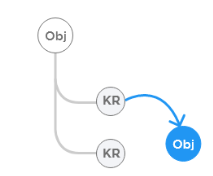
1A : A higher level KR can be assigned as an Objective to an individual
To establish alignment between an individual and the company’s higher-level key results, a practical approach is to implement the top-down alignment strategy. Using this scenario you can effectively connect the dots between overarching objectives and the specific contributions of individuals, fostering a clear line of sight and maximizing overall organizational performance.

Here you can see that the Keyresult Increase leads from 1k to 3k is assigned as an objective to Harris Edward. By working on this Objective, he will contribute to the company’s overall goal.

1B. Higher-level KR can be assigned as an objective to a department
By aligning higher-level Key Results with the departmental objectives, companies ensure that the efforts of each department contribute directly to the achievement of overarching goals. This practice fosters synergy, coordination, and a shared sense of purpose across different departments, enabling them to work cohesively toward the organization’s success.
Here, you can see that the organizational key result aligned with the department named customer success.
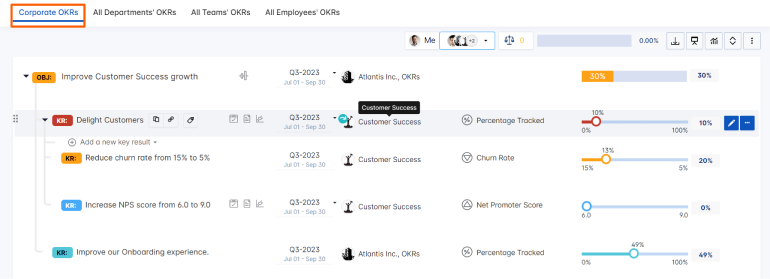
Here, you can see that the key result is assigned as an objective to the customer success department.

1C. Higher-level KR can be assigned as an objective to a team
By linking higher-level Key Results with the team’s objective, organizations establish a direct connection between the team’s activities and the attainment of strategic outcomes. This alignment fosters a heightened sense of focus, collaboration, and accountability within the team, empowering them to generate results that align harmoniously with the broader objectives of the departments and the organization.
One of the key results created under corporate OKRs is aligned with the event management team.
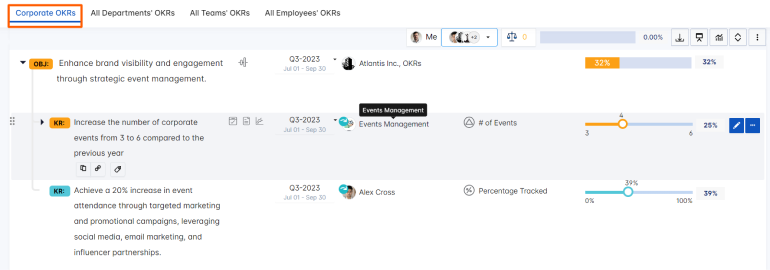
Here, you can see that one of the key results of the corporate OKRs is assigned as an objective to a team named Event Management.

2. Assign a KR as a KR / Sub KRs
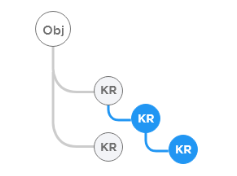
2A. Any level KR can be assigned as a KR/Sub KR to an Individual
Assigning Key Results (KR) or Sub Key Results (Sub KR) at any level to individuals is a flexible approach that enhances goal alignment within an organization. This practice enables individuals to have clear targets that directly contribute to achieving larger Key Results, ensuring their efforts are focused and impactful.
Under All Department OKRs, the key results created can be assigned as a KR to any individual.
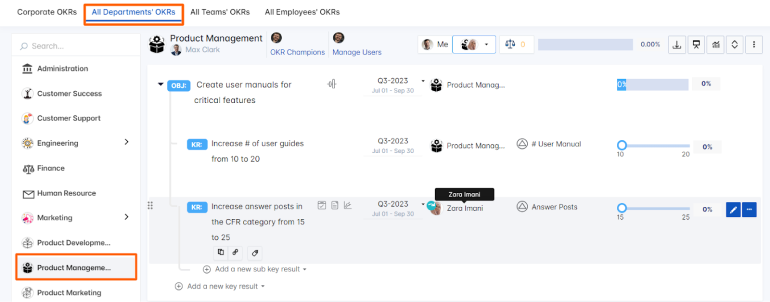
Here you can see that one of the key results of the Department name Product Management is assigned as a key result to Zara Imani

2B. Any level KR can be assigned as a KR/Sub KR to a department.
Assigning any level KR as a KR/Sub KR to a department promotes a strategic alignment between the department’s objectives and the broader organizational goals. This approach ensures that the department’s efforts are specifically targeted towards the achievement of key outcomes.
Here you can see that the sales Department KR is assigned as a key result of the marketing department.
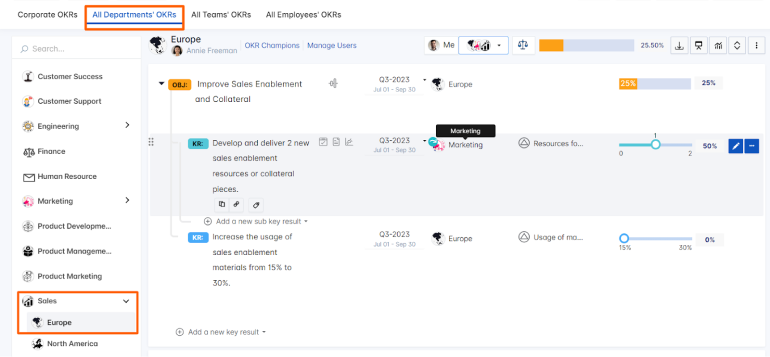
Here we can see both the sales and marketing departments sharing the same key result.
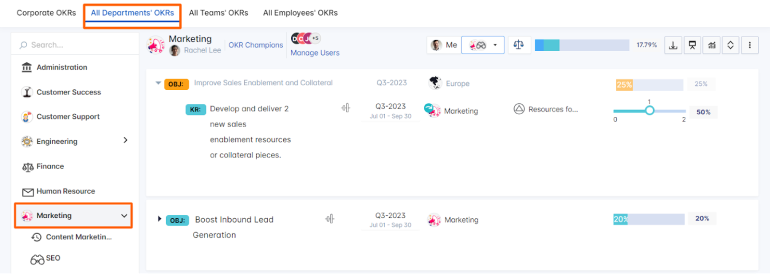
2C. Any level KR can be assigned as a KR/Sub KR to a team.
This scenario underlines the adaptability of the KR alignment process with respect to teams. Regardless of where a KR initially stands it can be repositioned and assigned to a specific team. When allocated to a team, it can either remain as the primary KR or be subdivided into more specific sub-KRs for that team.
One of the keyresult of the Social media department is assigned as keyresult to a team named Event management
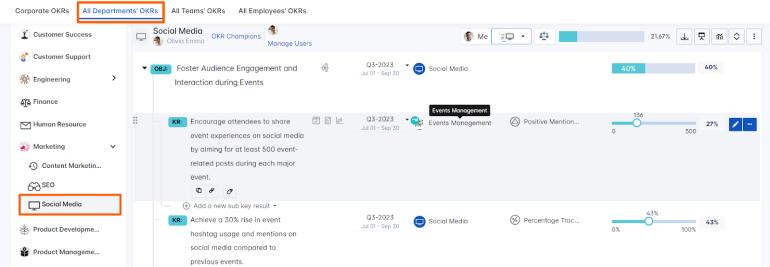
Here, you can see the key result under the Event Management Team.

II. Bottom-Up Alignment
3. Aligning the Objective as a Key Result to another Objective.
3A. Align an individual objective as a contributing KR to another objective.
When setting goals, an individual’s objective can be repositioned as a Key Result (KR) that feeds into a larger objective, ensuring that personal aims actively support and drive broader organizational ambitions. This alignment ensures cohesion between individual and collective efforts, streamlining progress toward overarching targets.
Annie Freeman’s objective is assigned as a key result under an objective of corporate OKRs.

Here, you can see that one of Annie Freeman’s objectives is aligned with one of the corporate OKRs

3B. Align a department objective as a contributing KR to another objective.
To align a department objective with another objective, the department can adopt one of the key results of the other objective as its objective. This way, the department can directly contribute to the achievement of the other objective and also create its own key results to measure its progress. This helps create clarity and focus for the department.
You can align Department key results with any of the objectives of corporate OKRs.
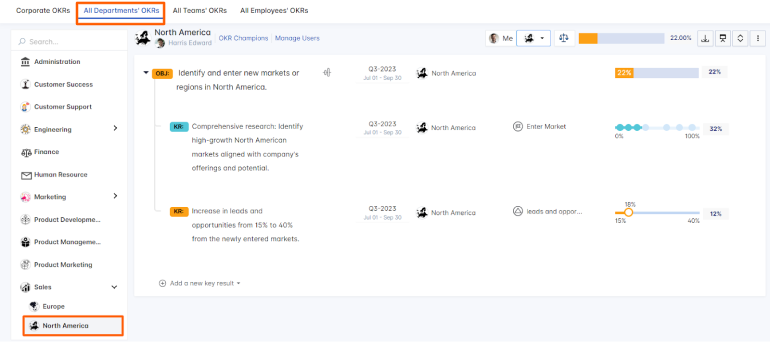
Here, you can see the objective of the sales department is aligned with the objective of corporate OKRs.

3C. Align a Team Objective as a contributing KR to another objective.
To align a team objective with another objective, the team can choose one of the key results of the other objective relevant to its scope and expertise. The team can then use this key result as its own objective and define its own key results to achieve it. This way, the team can align its efforts with the overall direction of the organization and also track its own performance.
The objective of any team can be contributing as a key result to corporate OKRs

Here, you can see the Team’s objective aligned as a key result to one of the objectives of corporate OKRs.

4. Align the Key Result as a Key Result to objective
4A. Align an individual’s KR as a KR to another objective.
Implies that a specific Key Result (KR), initially set for an individual’s target, is being adjusted or repurposed to support and measure progress toward a different overarching objective. Essentially, it’s about re-evaluating and ensuring that the individual’s measurable outcome (KR) is still relevant and directly contributes to achieving a new or different broader goal (Objective).
Matt Simpson’s key result is assigned to a key result to a totally different objective from any department or team.

Here, you can see that Matt Simpson’s key result is aligned with the objective of the Engineering department.
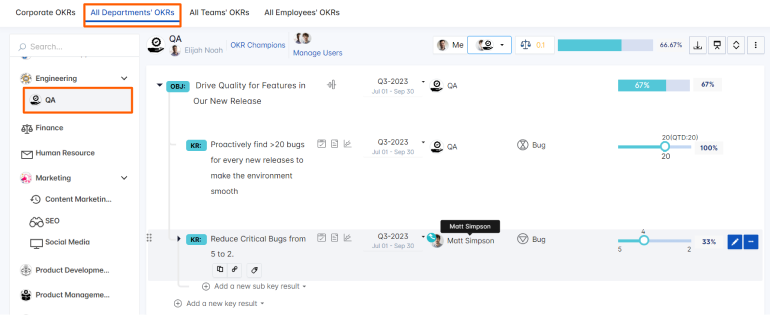
4B: Align a Department KR as a KR to another objective.
This means initially setting a specific Key Result (KR) for a particular department’s goal and adjusting or repurposing it to support a different overarching objective. It ensures that the department’s measurable outcome (KR) remains relevant and directly contributes to achieving this new or different broad goal (Objective).

Here, you can see the key result of the Marketing department is aligned with one of the objective of the corporate OKRs

4C: Align a Team KR as a KR to another objective.
Adjusting a specific Key Result (KR) initially set for a team’s goal ensures it supports and measures progress toward a different overarching objective. It is like repositioning the team’s measurable target (KR) to align with a new or revised broader aim (Objective) at any level.
One of the key result of the SEO Team is aligned with one of the objective of the marketing department.
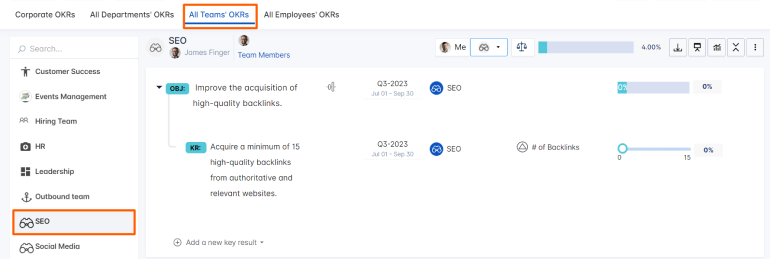
Here, you can see that one of the key result of the SEO team aligned with the objective of the Marketing department.

5. Align a key result as Sub-Key Result to a key result
5A. Align an individual’s KR as a sub-KR to another KR.
This scenario insists on taking a specific Key Result (KR) initially set for an individual and designating it as a secondary or supporting metric under a larger, primary Key Result. Essentially, the individual’s KR becomes a sub-key result or component of the broader KR, indicating that achieving the individual’s KR contributes to achieving the main KR.
Here, Helen Zhuo’s individual keyresult is aligned as a sub-keyresult to one of the key result of the Marketing department.

Here, you can see how the key result is perfectly aligned as a sub-key result, thereby it not only contributes to the key result but also to the overall progress of the objective of the marketing department.

5B. Align a Department KR as a sub-KR to another KR.
This means taking a specific Key Result (KR) initially set for a department’s goal and positioning it as a secondary or supporting metric under a primary, overarching Key Result. In this context, the department’s KR becomes a component or subset of the main KR, suggesting that achieving the department’s KR will contribute to fulfilling the larger KR.
Under the Marketing department, the SEO team’s key result is aligned as a sub-key result to one of the key result of the corporate OKR.

Here, you can see the key result aligned as a sub-key result under corporate OKRs.
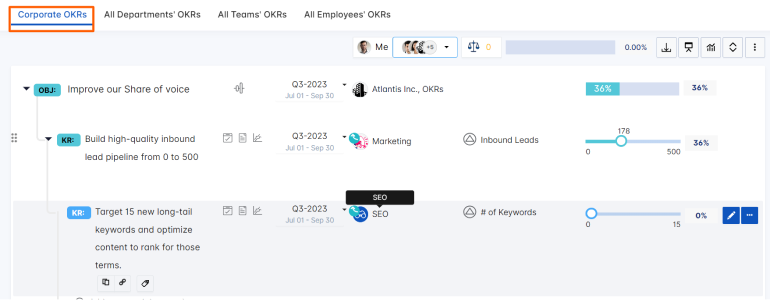
5C. Align a Team KR as a sub-KR to another KR
This scenario means taking a specific Key Result (KR) that was originally set for a team’s objective and placing it as a subordinate or supporting metric beneath a more dominant Key Result. Here, the team’s KR acts as a sub-key result or contributing factor of the primary KR of any level, signifying that accomplishing the team’s KR aids in progressing towards the main KR.
Here, you can see one of the key results of the Event Management team aligned as the sub-key result to one of the main KR of the Human resource department
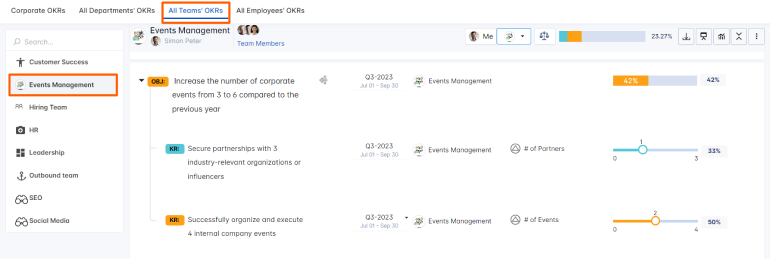
In this image you can see the alignment cascaded down as the sub-key result, contributing to the main keyresult of the human resource department.
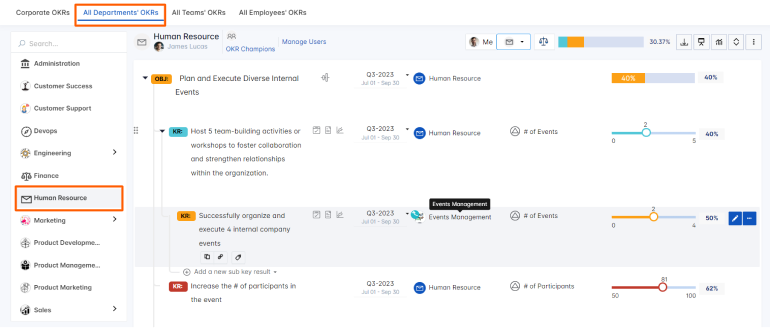
6. Aligning the Objective as a Sub Key Result to another Key Result.
6A. Align an individual’s objective as a sub-key result to another Key Result.
This scenario means taking a broad goal or objective initially set for an individual and repositioning it as a secondary or supporting metric under a larger, primary Key Result. In this context, the individual’s objective becomes a component or subset of the overarching KR, suggesting that achieving the individual’s objective will contribute to the progression and fulfillment of the main KR.
Here, Timothy Maxwell’s objective is aligned as a sub-key result to one of the key result of the Social media team.

You can see the alignment made between different levels.
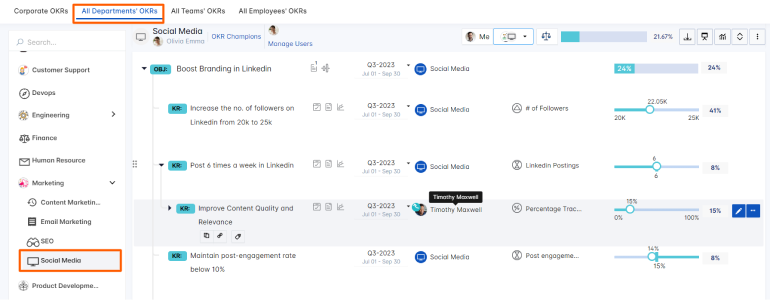
6B. Align a department objective as a sub-key result to another key result.
This scenario implies taking a broad goal or objective initially established for a department and redefining it as a secondary or supportive metric beneath a primary Key Result. Here, the department’s objective becomes a sub-key result or contributing element of the overarching Key Result, indicating that meeting the department’s objective will aid in achieving the main Key Result.
Here the objective of the customer success department is aligned as one of the sub-keyresult of the one of the KRs of corporate OKRs.

You can see the objective of the customer success department aligned as sub-key result of one of the KR of Corporate OKRs
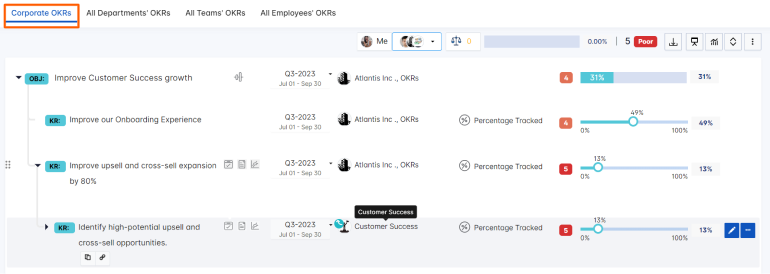
6C. Align a team objective as a sub-key result to another key result.
This scenario insists on positioning a broader goal initially set for a team as a secondary or subordinate metric under a larger, primary Key Result. In this arrangement, the team’s objective serves as a supplementary measure, indicating that fulfilling the team’s objective will play a part in progressing toward or achieving the primary Key Result.
Here, the objective of a Social media team is aligned as the sub-key result of the the KR of the Marketing department.
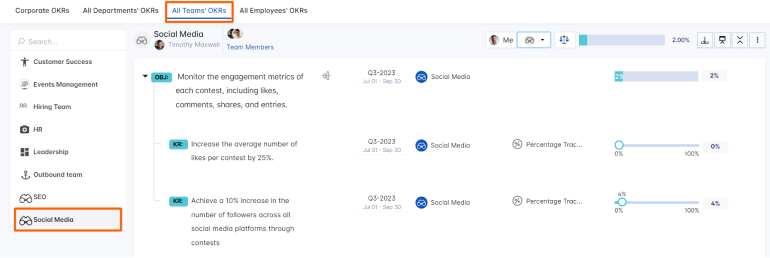
In this image, you can see the team’s objective perfectly aligned as a sub-key result of the KR in the Marketing department.
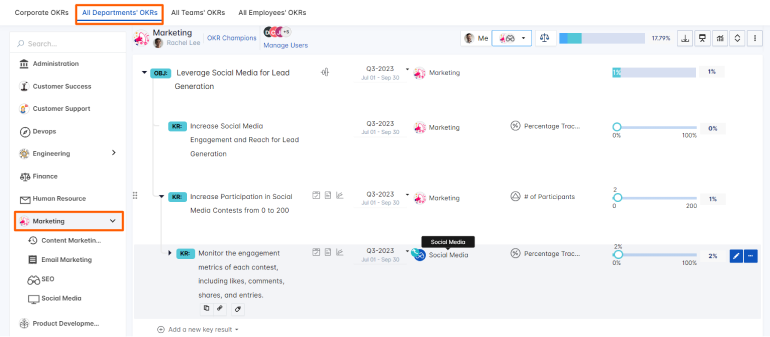
Difference between Top-Down and Bottom-Up Alignment
Know the Top Differences Between Top-Down Alignment and Bottom -Up Alignment
| Features | Top-Down Alignment | Bottom-Up Alignment |
|---|---|---|
| Definition | Objectives are set by top-level management | Objectives are set by individual teams |
| Flow of Direction | Cascades from the top to lower levels | Flows from individual teams to upper levels |
| Control | Centralized control and decision-making | Decentralized control and autonomy |
| Alignment Process | Strategic goals drive objective setting | Team objectives inform strategic goals |
| Result | Sets the tone and priorities for the entire organization | Encourages ownership and innovation at the grassroots level |
Top-down alignment provides a strategic direction, ensuring that the organization’s overall objectives are communicated clearly and cascaded down through different levels. It sets the tone and priorities for the entire organization, aligning individual efforts with the broader mission. Top-down alignment establishes a unified focus, fosters consistency, and enables efficient resource allocation.
On the other hand, bottom-up alignment empowers teams and individuals to contribute their unique perspectives and expertise. It encourages ownership and innovation at the grassroots level, allowing teams to identify key objectives and key results that align with their specific roles and responsibilities. Bottom-up alignment promotes a sense of autonomy, engagement, and accountability among team members, leading to increased motivation and creativity.
Both approaches are necessary for a well-rounded OKR implementation. Top-down alignment provides strategic guidance and ensures alignment with the organization’s overall vision, while bottom-up alignment enables teams to take ownership, adapt to dynamic situations, and contribute their expertise to achieving the objectives.
Ultimately, the magic lies in finding the right balance between top-down and bottom-up alignment. Organizations must foster a culture of collaboration and open communication, where leadership sets the direction and teams have the freedom to propose and execute initiatives that align with the broader objectives.
Final Thoughts
In a world where collaboration is the catalyst for extraordinary achievements, OKR alignment not only elevates your organization’s true potential but also enhances employee engagement. Engaged employees are at the heart of innovation, bringing forth ideas and solutions that drive organizational success. This alignment fosters a deeper connection between individual roles and overarching goals, ensuring that everyone feels valued and understands their contribution. It ignites organizational passion, fuels innovation, and propels you toward a goal-oriented strategic execution. Embrace the power of OKR alignment, and watch as your organization and its engaged workforce reach new heights together.
